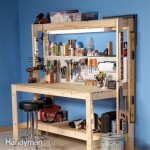Homemade Bike Rack for Garage
Storing bicycles efficiently and safely is a common concern for cyclists. A cluttered garage can make accessing tools and other equipment difficult, while improperly stored bikes risk damage. Building a homemade bike rack offers a customizable and often cost-effective solution to these storage challenges. This article will explore various DIY bike rack options and the steps involved in their construction.
Several factors should be considered when planning a homemade bike rack. Available space within the garage, the number of bikes to be stored, and the weight of the bikes are primary considerations. The available budget and DIY skill level also influence the choice of design and materials.
One of the simplest designs is the wall-mounted hook rack. This involves installing sturdy hooks directly into wall studs or using heavy-duty anchors. The hooks can be spaced to accommodate the handlebars or frames of the bikes, allowing them to hang vertically. This design maximizes floor space but requires careful placement to avoid interference with other garage items.
A more robust wall-mounted option involves using wooden beams or metal rails. These provide a more substantial mounting surface and can accommodate more bikes. Bikes can be hung from hooks attached to the beams or rails, or from specialized hangers designed to grip the wheels. This design offers greater stability and is suitable for heavier bikes.
For freestanding options, a floor-standing rack is a popular choice. These racks can be built from wood, PVC pipe, or metal. A simple design involves creating two A-frames and connecting them with horizontal bars. Bikes can then be leaned against the horizontal bars or secured with hooks or bungee cords. This design is easily adaptable to different bike sizes and quantities.
A more advanced freestanding option is the vertical bike stand. This design typically uses two vertical posts connected by horizontal supports. Specialized cradles or hooks hold the bikes upright, minimizing the required floor space. This option is well-suited for tight spaces and can offer a more organized look.
When building a homemade bike rack, material selection is crucial for safety and durability. For wall-mounted racks, ensure that screws and anchors are appropriate for the wall type and the weight of the bikes. For wooden racks, pressure-treated lumber is recommended to resist rot and insect damage. Metal racks should be constructed from rust-resistant materials like galvanized steel or aluminum.
Before beginning construction, gather all necessary tools and materials. Common tools include a measuring tape, drill, saw, level, and screwdriver. Safety equipment such as safety glasses and gloves should also be utilized. Having a well-defined plan, including measurements and a materials list, will streamline the construction process.
Accurate measurements are crucial for a stable and functional bike rack. Carefully measure the available space and the dimensions of the bikes to determine the appropriate size and spacing for the rack components. Marking the locations for hooks, supports, and other hardware ensures proper alignment and stability.
During construction, ensure all connections are secure and stable. Use appropriate fasteners and techniques for the chosen materials. For wooden racks, wood glue can add extra strength to joints. For metal racks, welding or bolting provides secure connections. Regularly check the rack's stability throughout the construction process.
After completing the construction, inspect the rack thoroughly for any loose connections or sharp edges. Sand down any rough areas on wooden racks and apply a sealant or paint for protection. For metal racks, consider applying a rust-resistant coating. Test the rack's stability with a bike before fully loading it.
Regular maintenance is essential to ensure the longevity and safety of the bike rack. Periodically inspect the rack for signs of wear and tear, including loose connections, rust, or damage. Tighten any loose screws or bolts and repair or replace any damaged components promptly. Keeping the rack clean and dry can also help prevent rust and corrosion.
Adapting the design to individual needs and preferences is a significant advantage of building a homemade bike rack. The height, spacing, and configuration can be tailored to accommodate specific bike types and sizes. Adding features such as shelves, baskets, or tool hooks can further enhance the functionality of the rack.
Building a homemade bike rack offers a practical and rewarding solution for organized bike storage. With careful planning, material selection, and construction, a DIY bike rack can provide a safe, efficient, and customized storage solution tailored to individual needs.

Easy And Diy Bike Rack House Becoming Home

Diy Simple Bike Rack In The Garage For

Diy Simple Bike Rack In The Garage For

10 Smart Diy Bike Rack Ideas For Your Garage The Handyman S Daughter

10 Smart Diy Bike Rack Ideas For Your Garage The Handyman S Daughter

How To Make A Diy Bike Rack For 20 Storage Stand Cabinet Garage Crafted Work

404 Not Found Bike Storage Diy Rack Garage

Diy Bike Rack For 20 Storage Stand Cabinet Garage Crafted Work

Easy And Diy Bike Rack House Becoming Home

Diy Bike Rack For 20 Storage Stand Cabinet Garage 5 Steps With Pictures Instructables
Related Posts








